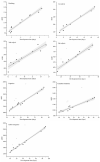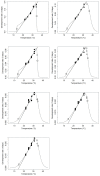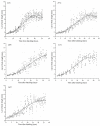Development of Necrobia ruficollis (Fabricius) (Coleoptera: Cleridae) under Different Constant Temperatures
- PMID: 35447761
- PMCID: PMC9026447
- DOI: 10.3390/insects13040319
Development of Necrobia ruficollis (Fabricius) (Coleoptera: Cleridae) under Different Constant Temperatures
Abstract
Necrobia ruficollis (Fabricius, 1775) (Coleoptera: Cleridae) is an important cosmopolitan storage pest, and also frequently appears on highly decomposed and skeletonized corpses. It is a forensically important species expected to indicate a longer postmortem interval (PMI). Therefore, we investigated the development of N. ruficollis at five constant temperatures between 22 °C and 34 °C. Under temperatures of 22, 25, 28, 31, and 34 °C, the mean (±SD) developmental durations from eggs to adults were 93.00 ± 1.63, 70.67 ± 0.94, 65.33 ± 3.40, 47.33 ± 0.94, and 56.66 ± 8.73 days, respectively. According to the developmental time and accumulated degree hours results, an isomorphen diagram and thermal summation model were generated. The calculated values of developmental threshold temperature and accumulated temperature constant were estimated by a linear model to be 14.51 ± 0.52 °C and 684.12 ± 33.85 degree days, respectively. Lower developmental thresholds, intrinsic optimum temperature, and upper lethal developmental threshold temperature were estimated by a nonlinear model to be 14.61, 25.90, and 34.94 °C. Morphological indexes of larvae were obtained by in vivo measurements. A growth curve and an equation of the relationship between development time and body length were simulated. In addition, the widths of the head capsules and the distance between the urogomphi of larvae at different instars were determined by cluster analysis. Classifiers were created and validated by linear discriminant analysis. These results provide important basic developmental data for using N. ruficollis to estimate the minimum postmortem interval (minimum PMI). However, this study was only conducted under constant temperature, and the applicability of these data to variable temperature conditions needs to be further confirmed.
Keywords: Necrobia ruficollis; development; forensic entomology; in vivo measurement; instar determination.
Conflict of interest statement
The authors declare no conflict of interest.
Figures







Similar articles
-
Temperature-Dependent Development of Nitidula rufipes (Linnaeus, 1767) (Coleoptera: Nitidulidae) and Its Significance in Estimating Minimum Postmortem Interval.Insects. 2023 Mar 20;14(3):299. doi: 10.3390/insects14030299. Insects. 2023. PMID: 36975984 Free PMC article.
-
Development of Necrobia rufipes (De Geer, 1775) (Coleoptera: Cleridae) under constant temperatures and its implication in forensic entomology.Forensic Sci Int. 2020 Jun;311:110275. doi: 10.1016/j.forsciint.2020.110275. Epub 2020 Apr 1. Forensic Sci Int. 2020. PMID: 32279028
-
Developmental time pattern of Thanatophilus sinuatus at different constant and variable temperatures.Forensic Sci Int. 2025 Jan;366:112301. doi: 10.1016/j.forsciint.2024.112301. Epub 2024 Nov 16. Forensic Sci Int. 2025. PMID: 39566345
-
Minimal Thermal Requirements for Development and Activity of Stored Product and Food Industry Pests (Acari, Coleoptera, Lepidoptera, Psocoptera, Diptera and Blattodea): A Review.Insects. 2019 May 23;10(5):149. doi: 10.3390/insects10050149. Insects. 2019. PMID: 31126156 Free PMC article. Review.
-
Research Progress on Species Identification of Sarcosaprophagous Flies.Fa Yi Xue Za Zhi. 2021 Jun;37(3):305-307. doi: 10.12116/j.issn.1004-5619.2021.410208. Fa Yi Xue Za Zhi. 2021. PMID: 34379898 Review. Chinese, English.
Cited by
-
Human costal cartilage, tooth cavities, and femur nutrient canals-new niches for insects used in forensic entomology.Forensic Sci Res. 2024 Apr 23;10(2):owae028. doi: 10.1093/fsr/owae028. eCollection 2025 Jun. Forensic Sci Res. 2024. PMID: 40271218 Free PMC article.
-
A global perspective of forensic entomology case reports from 1935 to 2022.Int J Legal Med. 2023 Sep;137(5):1535-1553. doi: 10.1007/s00414-023-03053-7. Epub 2023 Jul 6. Int J Legal Med. 2023. PMID: 37410176 Review.
-
Research Status of Sarcosaprophagous Beetles as Forensic Indicators.Insects. 2024 Sep 17;15(9):711. doi: 10.3390/insects15090711. Insects. 2024. PMID: 39336679 Free PMC article. Review.
-
Guidelines for laboratory rearing of insect evidence: the importance of air humidity for breeding of Necrodes littoralis (L.) (Coleoptera: Staphylinidae).Sci Rep. 2025 Mar 12;15(1):8607. doi: 10.1038/s41598-025-92196-1. Sci Rep. 2025. PMID: 40075144 Free PMC article.
-
Temperature-Dependent Development of Nitidula rufipes (Linnaeus, 1767) (Coleoptera: Nitidulidae) and Its Significance in Estimating Minimum Postmortem Interval.Insects. 2023 Mar 20;14(3):299. doi: 10.3390/insects14030299. Insects. 2023. PMID: 36975984 Free PMC article.
References
-
- Huntington T.E., Weidner L.M., Hall R.D. Introduction: Current Perceptions and Status of Forensic Entomology. In: Byrd J.H., Tomberlin J.K., editors. Forensic Entomology: The Utility of Arthropods in Legal Investigations. CRC Press; New York, NY, USA: 2019. pp. 23–34.
Grants and funding
LinkOut - more resources
Full Text Sources

